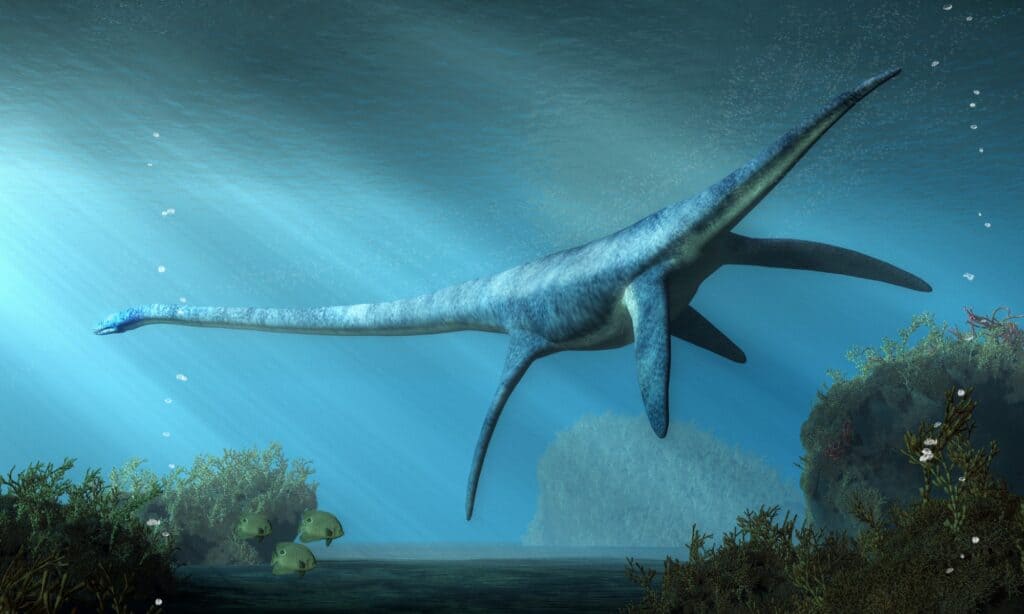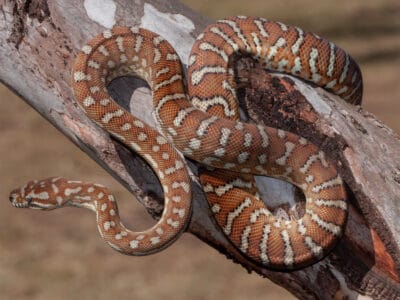Elasmosaurus
.jumbotron {
background-image: url(“https://a-z-animals.com/media/2022/05/Elasmosaurus-header-400×300.jpg”);
}
}
@media only screen and (min-width: 641px) and (max-width: 920px) {
.jumbotron {
background-image: url(“https://a-z-animals.com/media/2022/05/Elasmosaurus-header-470×370.jpg”);
}
}
@media only screen and (min-width: 921px) {
.jumbotron {
background-image: url(“https://a-z-animals.com/media/2022/05/Elasmosaurus-header.jpg”);
}
}
Elasmosaurus
†Elasmosaurus platyurus
Elasmosaurus is an extinct reptile species.
Elasmosaurus Scientific Classification
- Kingdom
- Animalia
- Phylum
- Chordata
- Class
- Reptilia
- Order
- †Plesiosauria
- Family
- †Elasmosauridae
- Genus
- †Elasmosaurus
- Scientific Name
- †Elasmosaurus platyurus
Read our Complete Guide to Classification of Animals.
Elasmosaurus Conservation Status
Elasmosaurus Facts
- Fun Fact
- Elasmosaurus is an extinct reptile species.
- Distinctive Feature
- Long neck; triangular head; fang-like front teeth.
This post may contain affiliate links to our partners like Chewy, Amazon, and others. Purchasing through these helps us further the A-Z Animals mission to educate about the world’s species..

Spiders that fly! Fish that walk! And 1000+ more incredible animals. Discover them all for FREE
.photo-gallery {
–margin: 0px auto 0px;
–padding: 0px 0px 0px 0px;
}
.gallery-link {
background-image: url(“https://a-z-animals.com/media/2022/05/Elasmosaurus-header-1024×614.jpg”);
background-repeat: no-repeat;
background-size: cover;
background-position: center;
height: 500px;
justify-content: center;
text-align: center;
align-items: center;
display: flex;
border: 2px solid #000;
}
.gallery-link img {
height: 50%;
}
@media only screen and (max-width: 768px) {
.gallery-link {
height: 300px !important;
}
}
View all of the Elasmosaurus images!
Description & Size
Elasmosaurus is a genus of plesiosaur, which loosely translates to mean “thin-plate reptile” or “flat-tailed.” Though it is often associated with dinosaurs that traveled underwater, they aren’t actually a dinosaur – they are an extinct reptile species. They were the first to be identified as a plesiosaur, and every variation of plesiosaur came after them. To date, the only specimen that has been officially recorded as an Elasmosaurus (holotype specimen ANSP 10081) is missing a lot, but researchers have put together what they believe this reptile would’ve been like with the influence of related Elasmosaurids.
These reptiles measured approximately 34 feet (or 10.3 meters) long, featuring streamlined bodies with legs shaped like paddles to move their huge bodies around. Instead of legs, the Elasmosaurus seemed to have flippers, helping them to swim through the waters. Without flexible necks, their flippers were responsible for getting them closer to their prey. Their head had a triangular shape, featuring a large jaw with fang-like teeth in the front and smaller teeth towards the back of their mouth. Based on the current specimens available, they most likely had about 40 teeth in total.
Due to the extreme length of the Elasmosaurus’s neck, researchers don’t believe that it could’ve risen its head very far above the water. Though the body measured over 30 feet, the long neck accounts for about 23 feet of its total length. Based on what we currently know about ancient animals and dinosaurs, the Elasmosaurus has a longer neck than almost any animal to have ever existed. Their neck vertebrae showed compression, and they may have had a crest on the sides. Due to the weight and structure of the neck, researchers are still unsure why it needed to be so long, though some researchers have connected it to feeding.
Even with these estimates, it is likely that the living reptile would’ve been much bigger because of the cartilage that they had, reaching about 45 feet at their full length. With its rounded and flat nose, it appeared to have a semi-circle on its face when looking from above.
Based on researchers in 1906, the pelvic girdles and pectoral girdles are still missing, while the shoulder blades don’t seem to have a median bar, measuring broadly across the back with great length.
Diet – What Did the Elasmosaurus Eat?
What did the Elasmosaurus eat? While it seems impossible to get a clear view of what food was available to the Elasmosaurus millions of years ago, most researchers believe that the reptile is a carnivore that rules the seas as an apex predator. Much of its diet seemingly consisted of fish, though they also consumed cephalopods, which are related to the squids and octopuses of the present day. Though they were ambush predators, they moved slowly and used their fang-like teeth to grab their prey. They possibly consumed other marine invertebrates, and the use of gastroliths probably played a role in their digestion.

Daniel Eskridge/Shutterstock.com
Habitat – When and Where the Elasmosaurus Lived
Based on the current paleoecology research surrounding their fossils, the Elasmosaurus most likely lived in North America, swimming the seas around 80.5 million years ago in an era known as the Late Cretaceous period. Instead of being found off the coast, they were likely located within the middle of the continent, which was the home to an ancient sea that has since dried up.
The sea was once in the Midwest around Kansas, found near the Western Interior Seaway, which was shallow but still managed to cover much of North America during the Cretaceous period. At one point, these waters stretched from the Rocky Mountains to the Appalachian Mountains, reaching a depth of no more than 3,000 feet deep.
With a soft and muddy texture along the floor, this sea was likely to be full of aquatic life, giving the Elasmosaurus plenty of organisms to ingest. The floors were covered with oysters, but the biodiversity was minimal. At best, the sea life in this area probably accumulated through many years. Some of the fish that might’ve been in this area for them to consume include bony fishes (like the Enchodus and Saurodon), sharks (like Cretoxyrhina and Cretolamna), and other marine reptiles.
Threats And Predators of the Elasmosaurus
Being one of the first marine reptiles that paleontologists discovered, there has yet to be a predator found. Researchers believe the Elasmosaurus to be an apex predator, ranking at the top of the food chain.
Discoveries and Fossils – Where Was the Elasmosaurus Found?
The first discovery of the Elasmosaurus was recorded near Fort Wallace, Kansas in 1867. The specimen was sent to a local paleontologist named Edward Drinker Cope who named it the E. platyurus. When he first assembled the incomplete skeleton, he placed the skull at the wrong end of the body, which was quickly pointed out by rival Othniel Charles Marsh, starting their competition that was colloquially known as the Bone Wars. The structure included most of a skull, a spine, pectoral and pelvic girdles, and vertebrae.
The bones were originally discovered by an army surgeon (Theophilus Hunt Turner) and army scout (William Comstock) who were exploring the area near the Union Pacific Railroad where they were stationed. The bones were located in a ravine near the Pierre Shale formation. Despite having minimal paleontology knowledge, he understood that the bones came from an “extinct monster.” While three of the vertebrae were sent at the time, the rest wasn’t uncovered until Turner went back to recover it entirely upon Cope’s request. Though Turner died ahead of the final unveiling, Cope continued to attempt communication without knowing he had passed. Before the Elasmosaurus, no other fossil had been found in Kansas.
It wasn’t until later that Cope conceded that he had wrongly assembled the fossil. He tried to hide what he’d done by trying to get back all of his original article, replacing it with a correction with the proper placement of the head, and changed wording. He stated that he’d been misled at the time and showed his changed assembly of the skeleton in 1870. Despite all of his efforts to hide his original statement, Marsh managed to get a copy of the article and publicized what Cope had done. This publicity began their rivalry throughout their careers as paleontologists.
Extinction – When Did the Elasmosaurus Die Out?
While some prehistoric reptiles, dinosaurs, and other animals are linked to specific changes that likely took out their species, the researchers have found no conclusive reason for the Elasmosaurus’s extinction. It is believed that this reptile died out with the other marine reptiles at the end of the Cretaceous period.
This extinct reptile is one of the few that is connected to the Scottish lore of the Loch Ness Monster (a.k.a. Nessie). This mythical creature has a striking resemblance to the aquatic reptile, though researchers have not found any basis for this link. While the Loch Ness monster is only about 10,000 years old, the dating of the skeleton of the Elasmosaurus shows that it likely went extinct 65 million years ago.
Similar Animals to The Elasmosaurus
Similar animals to the Elasmosaurus include:
- Kronosaurus – This pliosaur measured about 36 feet long, and it looked much like today’s crocodiles. It had large flippers with a much shorter neck and a longer snout.
- Placodus – The name of this marine reptile literally translates to mean “flat tooth.” It existed during the Triassic period and swam in shallow waters.
- Apatosaurus – This large land dinosaur also lived in North America, but it existed during the late Jurassic Period and was an herbivore. However, its tail and neck were exceedingly long.
View all 68 animals that start with E
Elasmosaurus FAQs (Frequently Asked Questions)
When was the Elasmosaurus alive?
Researchers state that the Elasmosaurus most likely lived during the Cretaceous period, going extinct 65 million years ago. It was a slow-moving aquatic reptile that was found in seas that used to cover Kansas in the United States. Though the area is dry land now, it is unlikely that the dinosaur was ever able to walk on land.
How big was the Elasmosaurus?
The skeleton of the Elasmosaurus alone suggests that it was about 34 feet long with its neck accounting for about two-thirds of the total length. However, more recent research suggests that it could’ve been 45 feet long with the inclusion of cartilage along the tail, face, and rest of the body.
Sources
- Wikipedia, Available here: https://en.wikipedia.org/wiki/Elasmosaurus
- Kids-Disnosaurs, Available here: https://www.kids-dinosaurs.com/elasmosaurus.html
- Encyclopedia of Alabama, Available here: http://encyclopediaofalabama.org/Article/h-3554
- Britannica, Available here: https://www.britannica.com/animal/Elasmosaurus
- Wikipedia, Available here: https://en.wikipedia.org/wiki/Kronosaurus
- Wikipedia, Available here: https://en.wikipedia.org/wiki/Placodus
















